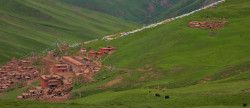Difference between revisions of "Gebchak Gonpa"
| Line 1: | Line 1: | ||
[[File:Gebchak_Gonpa.png|thumb|250px|]] | [[File:Gebchak_Gonpa.png|thumb|250px|]] | ||
| − | |||
| − | [[Gebchak Gonpa]] is renowned for its {{Wiki|training}} of {{Wiki|female}} practitioners. Its [[yogini]] [[Nuns]] are famed for their accomplishments in profound [[yogas]] and [[Meditation]], particularly in [[Tsa Lung]] and [[Dzogchen]]. Elderly [[Nuns]] resident today say they witnessed practitioners attain the [[Rainbow body | + | |
| + | |||
| + | |||
| + | [[Gebchak Gonpa]] - also spelled [[Gecha Gon]], [[Gechak]], [[Gechag]], and [[Gebchak Gompa]] - lies in the remote [[mountains]] of [[Nangchen]], Eastern [[Tibet]]. | ||
| + | |||
| + | It is the home of a [[Spiritual lineage of female practitioners]], or [[yogini]], a [[nunnery]] of 345 [[Nuns]] and the [[Heart]] of a renowned [[practice tradition]]. | ||
| + | |||
| + | Their practices come from the [[Kagyu]] and [[Nyingma]] schools within the [[Tibetan Buddhist tradition]]. | ||
| + | |||
| + | The third [[Wangdrak Rinpoche]] is the current [[abbot of Gebchak]]. | ||
| + | |||
| + | [[Gebchak Gonpa]] is renowned for its {{Wiki|training}} of {{Wiki|female}} practitioners. | ||
| + | |||
| + | Its [[yogini]] [[Nuns]] are famed for their accomplishments in profound [[yogas]] and [[Meditation]], particularly in [[Tsa Lung]] and [[Dzogchen]]. | ||
| + | |||
| + | Elderly [[Nuns]] resident today say they witnessed practitioners attain the [[Rainbow body of Spiritual Accomplishment]] in the early days of the [[nunnery]]. | ||
| + | |||
| + | |||
== History == | == History == | ||
| − | |||
| − | : Tsang-Yang followed Tsoknyi’s command and built two major [[nunneries]], one of which had thirteen [[Retreat]] centers. His [[benefit]] for [[beings]] became broader than his [[master’s]]. Most of the [[Nuns]] practiced the [[revealed treasures | + | The [[first Tsoknyi Rinpoche]] instructed his [[Heart]] son, [[Tsang-Yang Gyamtso]], [[to build]] [[nunneries]] so that women would have the opportunity to practice, thereby bringing [[Balance]] to an unbalanced [[World]]. |
| + | |||
| + | [[Tsang-Yang Gyamtso]], along with the [[first Wangdrak Rinpoche]], founded [[Gebchak Gonpa]] in 1892 and over [[Time]] great numbers of women came from many parts of [[Tibet]] came to join in its unique system of practice. According to [[Tulku Urgyen]] | ||
| + | |||
| + | : [[Tsang-Yang]] followed [[Tsoknyi’s]] command and built two major [[nunneries]], one of which had thirteen [[Retreat]] centers. His [[benefit]] for [[beings]] became broader than his [[master’s]]. | ||
| + | |||
| + | Most of the [[Nuns]] practiced the [[revealed treasures of Ratna Lingpa]], which include [[Hayagriva]] as well as the [[peaceful]] and [[Wrathful deities]]. Each [[Retreat]] center focused on a different cycle of these [[treasures]]. | ||
| − | Gebchak Gonpa's intensive [[Retreat]] system includes a three-year | + | [[Gebchak Gonpa's]] intensive [[Retreat]] system includes a [[three-year Retreat]] for all [[Nuns]] followed by entry into one of sixteen [[Retreat]] divisions, where they remain in practice for the rest of their [[lives]]. |
During the {{Wiki|cultural revolution}} of the 1960s [[Gebchak Gonpa]] was almost completely destroyed and the remaining [[Nuns]] were dispersed, threatening to destroy the [[tradition]] entirely. | During the {{Wiki|cultural revolution}} of the 1960s [[Gebchak Gonpa]] was almost completely destroyed and the remaining [[Nuns]] were dispersed, threatening to destroy the [[tradition]] entirely. | ||
Latest revision as of 13:25, 3 February 2016
Gebchak Gonpa - also spelled Gecha Gon, Gechak, Gechag, and Gebchak Gompa - lies in the remote mountains of Nangchen, Eastern Tibet.
It is the home of a Spiritual lineage of female practitioners, or yogini, a nunnery of 345 Nuns and the Heart of a renowned practice tradition.
Their practices come from the Kagyu and Nyingma schools within the Tibetan Buddhist tradition.
The third Wangdrak Rinpoche is the current abbot of Gebchak.
Gebchak Gonpa is renowned for its training of female practitioners.
Its yogini Nuns are famed for their accomplishments in profound yogas and Meditation, particularly in Tsa Lung and Dzogchen.
Elderly Nuns resident today say they witnessed practitioners attain the Rainbow body of Spiritual Accomplishment in the early days of the nunnery.
History
The first Tsoknyi Rinpoche instructed his Heart son, Tsang-Yang Gyamtso, to build nunneries so that women would have the opportunity to practice, thereby bringing Balance to an unbalanced World.
Tsang-Yang Gyamtso, along with the first Wangdrak Rinpoche, founded Gebchak Gonpa in 1892 and over Time great numbers of women came from many parts of Tibet came to join in its unique system of practice. According to Tulku Urgyen
- Tsang-Yang followed Tsoknyi’s command and built two major nunneries, one of which had thirteen Retreat centers. His benefit for beings became broader than his master’s.
Most of the Nuns practiced the revealed treasures of Ratna Lingpa, which include Hayagriva as well as the peaceful and Wrathful deities. Each Retreat center focused on a different cycle of these treasures.
Gebchak Gonpa's intensive Retreat system includes a three-year Retreat for all Nuns followed by entry into one of sixteen Retreat divisions, where they remain in practice for the rest of their lives.
During the cultural revolution of the 1960s Gebchak Gonpa was almost completely destroyed and the remaining Nuns were dispersed, threatening to destroy the tradition entirely.
Today the Nuns have returned to preserve this endangered tradition. Despite extreme physical hardships the few remaining elder Nuns are striving to pass on their Spiritual heritage to a new generation.
